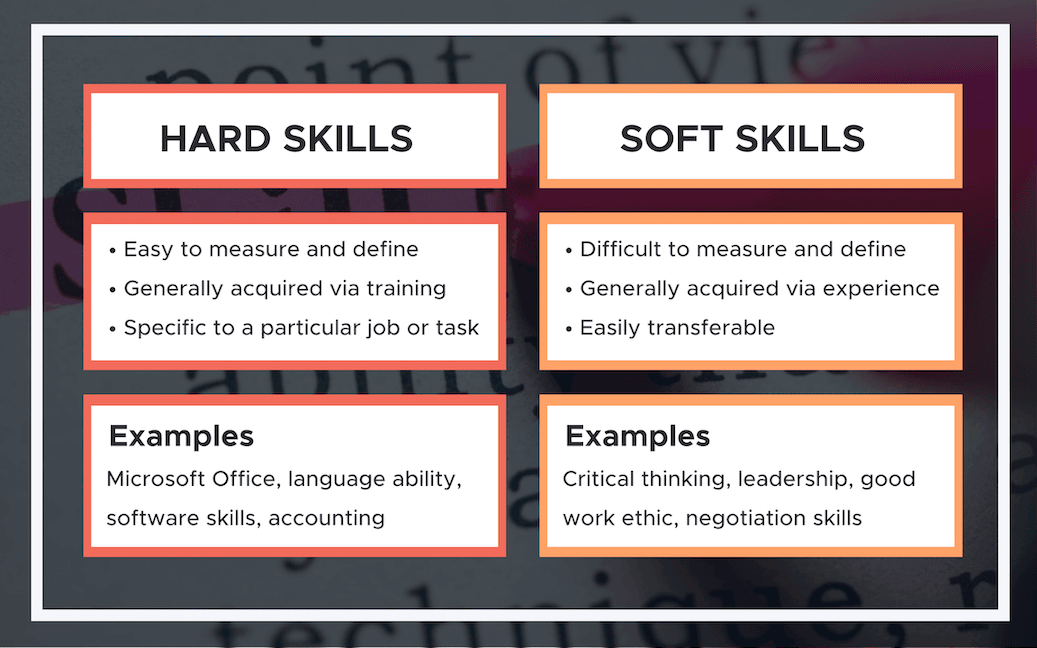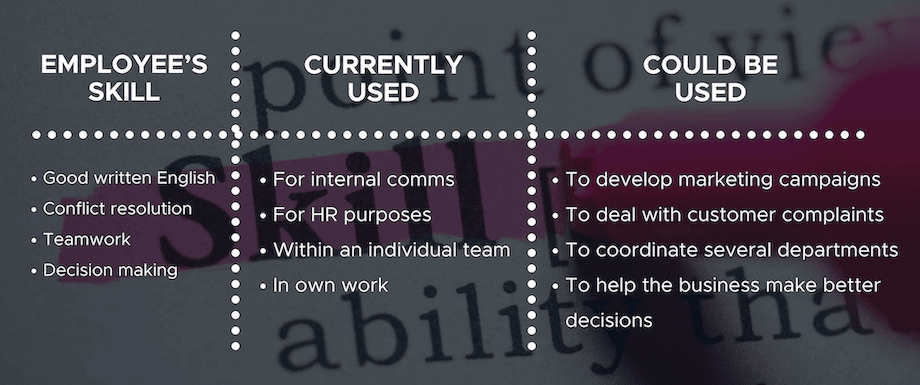10 Minutes of reading
Categorising skills
You’ve probably heard about hard and soft skills. The first refer to measurable talents and abilities – such as being able to create a graph using Excel – while the second refer to subjective skills that are more difficult to quantify, such as performing well under pressure.

Depending on the role, certain combinations of hard and soft skills will be preferred over others. But what about durable and perishable skills? And where do transferable and essential skills fit in?
When it comes to categorising skills within an organisation, relying solely on hard and soft skills is a bit too simplistic. Broadening your skills categories can enable you to develop an optimum approach to your business and your people.
Hard and soft skills
Let’s start with a recap of the basics.
Hard skills are easy to measure and define. They also tend to be specific to a particular profession or job requirement and tend to be taught via formal training. Some common examples include foreign language skills, bookkeeping, computer skills, coding ability and typing speed. More often than not, you’ll be able to list these types of skills on your CV, the level you have mastered them to and where you acquired training in them.
Soft skills, on the other hand, are a bit more difficult to define and measure. They tend to refer to universal attributes, such as ‘creativity’ or ‘adaptability’. Often, these will be skills that you have acquired through experience, rather than through formal training. As such, they don’t tend to be skills that can be listed on a CV but might be attributes that candidates mention in a personal statement or a job interview.

While hard and soft skills are measured and acquired differently, they do in fact complement one another. If you think about it, have you ever advertised for a role that only required hard skills?
For example, most engineers have a degree in engineering or closely related subject. That’s because their degree has likely given them the technical foundation they need to succeed in the role – but that doesn’t mean that soft skills aren’t important too. In fact, having the ability to lead a team or manage a project successfully might be crucial to success in certain engineering roles.
Moreover, while hard skills used to take precedence on the job market, many companies are starting to recognise the importance of soft skills – like critical thinking, resilience and emotional intelligence – as the skills of the future.
Durable and perishable skills
So, it’s important to give equal weight to hard and soft skills – but that’s only part of the story. While the hard and soft categories describe how a skill is measured and acquired, durable and perishable skills look at the long-term relevance of one skill or another.
Durable skills, as the name suggests, are skills that have longevity. They are transferable and can be applied throughout a career, rather than just in one specific role. For instance, if you’re a member of a panel or committee within your organisation and often find yourself having to summarise complex ideas to communicate them to others, you possess a durable skill that you could apply to another committee or to a different role.
Perishable skills, on the other hand, are finite. That’s because perishable skills tend to be linked to policies, tools or regulations, which can change regularly. Sometimes, the market can simply make certain skills redundant. For example, the rise in machine translation software may lead to the majority of human translators becoming redundant in the future. In this sense, translation may become a perishable skill. However, faced with this challenge, translators could either adapt their existing perishable skills (by helping AI experts to train translation tools in the short- to medium-term) or acquire new, durable skills (by specialising in an area that machine translation is unlikely to take over, such as translating subtitles or marketing slogans).

So, why should durable and perishable skills matter to your HR department? A good company that invests its employees will ensure that it develops the right mix of perishable skills – i.e., those in immediate demand – and durable skills – i.e., those that will benefit the organisation and the employee in the long-term.
And with the pace of technological change transforming the way we work, it is more important than ever to continue developing the skills of your workforce through high-quality training. Not only does this help your organisation to strengthen its agility, resilience and capacity for innovation, but it also gives employees a sense of purpose and value. It’s no wonder that the number one reason that employees leave their job is a lack of opportunity to upskill and develop professionally.
Transferable skills
As mentioned above, we can also describe skills as simply transferable. These are skills that can be easily transferred to other tasks or roles. These can include technical skills, such as knowledge of data analysis techniques, or soft skills, such as negotiation or rapport building skills.
Transferable skills are important for employees, as they make it easier for them to move over to a different department. They can also help with upward progression within an organisation. For example, being able to lead a small team is a skill that will come in handy at managerial or executive level. Similarly, communication skills are highly sought after in every industry, as they are often indicative of emotional intelligence and professionalism – two key attributes at senior leadership level.

According to the job site Indeed, there are 11 transferable skills that organisations attach particular importance to:
- Communication
- Dependability
- Organisation and time management
- Teamwork and collaboration
- Problem solving
- Decision making
- Initiative
- Conflict resolution
- Leadership
- Attention to detail
- Adaptability
It may be that some of the skills on this list are more relevant to your organisation than others. For instance, attention to detail is likely to be a highly important attribute in an accountancy firm, whereas problem solving is likely to take precedence in a computer programming role.
It’s therefore worth reflecting on what skills are particularly important to you. What transferable skills would be most valuable within your organisation?
Essential skills
Essential skills are the base level of skills that all your employees need to possess to be able to do their job effectively. For that reason, they tend to be universal skills, rather than skills specific to one job or role.
For instance, having a good command of written and spoken English is classed as an essential skill for most roles in the UK. Employers may ask candidates to evidence this (e.g., by supplying proof of their UK citizenship or a language proficiency certificate) or test this as part of the recruitment process (e.g., by asking them to undertake a written assessment or deliver a presentation in the interview).
While essential skills might seem obvious, they can evolve over time and are always worth stating on a job description. A good example is digital skills. Someone who you employed twenty years ago may not have needed to use a computer in their role, but nowadays, being able to use Microsoft Excel to produce a simple spreadsheet is a prerequisite for many administration or data entry roles.
Essential skills: a word of caution
While recruiting candidates with essential skills is certainly important, it’s worth thinking about whether you are setting the bar too high.
For example, many companies now stipulate that an ‘upper class second degree or higher’ is required in order for graduates to be eligible for their training schemes. There may be good reason for this – such as the fact that the role is complex and requires a certain level of academic intelligence – but this stipulation effectively excludes a vast number of candidates who might not have achieved the right grade but have lots of potential.
In this scenario, there are several solutions for attracting the best candidates while ensuring that you don’t exclude others who deserve the chance to shine within your organisation. What is it about the 2.1-degree classification that is important? For instance, if the role is maths-based, could you incorporate a test into the recruitment process instead, rather than asking for a specific degree classification? Alternatively, if you’re asking for three years of professional experience as a minimum, could you also consider candidates with one year of experience plus a highly relevant degree?
Categorising skills: what next?
Once you’ve categorised your skills, you can start thinking about what you want your employees to learn, and how. For instance, you could design a blended learning course, which combines in-person training with e-learning modules, offering trainees a varied, well-rounded and multi-format learning experience. Blended learning courses can even be tailored to suit trainees’ individual learning styles.
Before you get to that stage, you’ll need to do some planning to ensure that you find an approach that works best for your organisation. There’s no one way to do this, but here are some ideas to get you started:
Ask employees what skills they want to learn: You could do this by rolling out a staff survey, or by asking your staff during annual appraisals or informal catch-ups. Ask them what sorts of skills would make their job easier or more enjoyable. Would having a couple of hours out to take a refresher course in a skill they already have be beneficial? Alternatively, are they feeling left behind by digital technology and looking for some grounding in a new skill (e.g., SEO)?
Look at where you perform well as a business – and where you’re heading in future: It’s a good idea to link your skills to your values. What are the qualities that your organisation prides itself on, and how do your skill sets align with these? Are new skills likely to be needed as the business evolves, and how will you cater to this?
Break it down by department or job role: doing some big-picture thinking can be helpful, but it can be a bit overwhelming. Instead, why not home in on a specific department or profession within your organisation and look at the types of skills that your employees possess. You’ll likely have these written down already on old job advertisements.
Categorise the skills into hard/soft, durable/perishable, essential and transferable. Then, you can start building a picture of the skills you have. Are there any gaps that need bridging? Are there any skills that need to be developed further or future-proofed?
Become a learning organisation
Whatever you do, embedding learning across your organisation is a key route to success. Did you know that 85% of jobs that will exist in 2030 haven’t been invented yet? And that most employees leave their role because they don’t have the opportunity to grow or progress?
In this context, the best thing organisations can do is to offer great opportunities for training and professional development by embedding learning at the very heart of the organisation. While this might sound like a daunting task, it doesn’t have to be. You no doubt have a lot of internal expertise – it’s simply a case of tapping into it! For example, you could:
- hold seminars and workshops aimed at sharing internal knowledge and expertise across teams or departments;
- gamify aspects of your training to make it more fun for trainees (e.g., by having a leaderboard or introducing incentives);
- use learner feedback to create case studies in which you showcase how a particular skill has enabled an employee to work more effectively.


